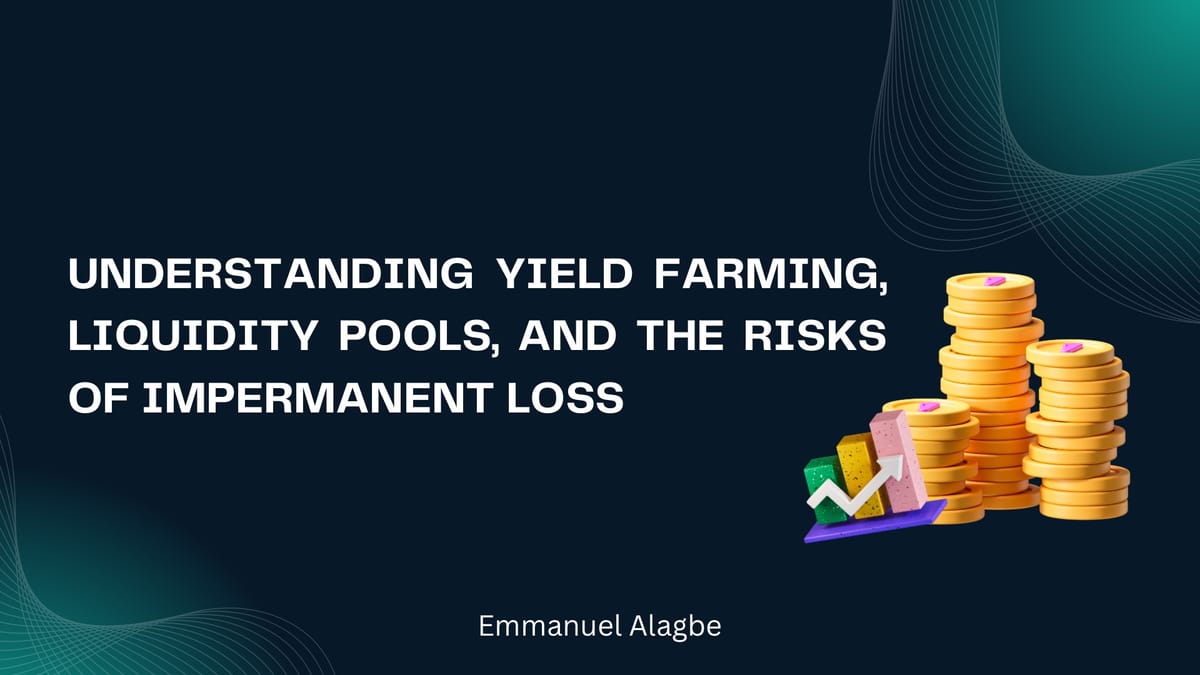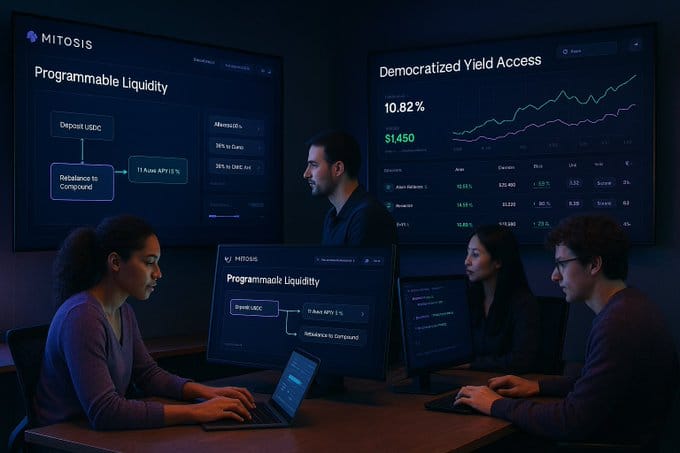Understanding Yield Farming, Liquidity Pools, and the Risks of Impermanent Loss

The decentralized finance (DeFi) ecosystem has introduced innovative ways to earn passive income through cryptocurrencies, with yield farming and liquidity pools being two of the most popular mechanisms. However, these opportunities come with risks, notably impermanent loss, which can impact returns. This article explores what yield farming and liquidity pools are, how they work, and the risks involved, providing a clear guide for those looking to navigate the DeFi space.

What is Yield Farming?
Yield farming, often referred to as "liquidity mining," is the process of lending or staking cryptocurrency assets in DeFi protocols to earn rewards, typically in the form of additional tokens. These rewards can come from transaction fees, interest, or governance tokens issued by the protocol. Yield farming leverages the power of decentralized platforms, such as Uniswap, Aave, or Compound, to generate returns that are often higher than traditional financial instruments.
The process involves depositing assets into a smart contract-based protocol, which then uses these funds to facilitate activities like lending, borrowing, or trading. In return, farmers earn a portion of the protocol’s revenue or newly minted tokens. The appeal of yield farming lies in its potential for high annual percentage yields (APYs), which can range from single digits to over 100% in some cases, though these returns fluctuate with market conditions.
Liquidity Pools: The Backbone of Yield Farming
Liquidity pools are the foundation of many yield farming strategies, particularly in decentralized exchanges (DEXs) like Uniswap, SushiSwap, or PancakeSwap. A liquidity pool is a collection of funds locked in a smart contract, provided by users known as liquidity providers (LPs). These pools enable peer-to-peer trading by ensuring there’s always liquidity for traders to swap tokens.
Here’s how it works:
- Depositing Assets: Liquidity providers deposit pairs of tokens (e.g., ETH and USDT) into a pool in equal value, as determined by the current market price.
- Earning Rewards: In return, LPs earn a share of the trading fees generated by the pool, proportional to their contribution. Some protocols also offer additional rewards in the form of governance tokens.
- Automated Market Makers (AMMs): Liquidity pools use AMM algorithms to determine token prices based on supply and demand within the pool, eliminating the need for traditional order books.
By contributing to liquidity pools, users enable decentralized trading while earning passive income. However, providing liquidity is not without its challenges, as it introduces specific risks, the most notable being impermanent loss.
Impermanent Loss: The Hidden Risk
Impermanent loss (IL) is a unique risk faced by liquidity providers in AMM-based liquidity pools. It occurs when the price of the tokens in a liquidity pool diverges from their price when they were initially deposited. This divergence results in a temporary loss of value for LPs compared to simply holding the tokens outside the pool.
How Impermanent Loss Works
When you deposit a pair of tokens into a liquidity pool (e.g., 50% ETH and 50% USDT), the AMM ensures the value of the pair remains balanced according to a constant product formula (e.g., x * y = k). If the price of one token (say, ETH) rises or falls significantly relative to the other, the pool automatically adjusts the token ratios to maintain the formula. This rebalancing means LPs end up with more of the less valuable token and less of the more valuable one.
For example:
- You deposit 1 ETH and 2,000 USDT (assuming 1 ETH = $2,000) into a pool.
- If ETH’s price rises to $3,000, arbitrage traders will buy ETH from the pool, reducing the amount of ETH and increasing the amount of USDT.
- When you withdraw, your share might now be 0.8 ETH and 2,400 USDT, which is worth less in dollar terms than holding 1 ETH and 2,000 USDT outside the pool.
This difference in value is impermanent loss. The loss is "impermanent" because it only materializes if you withdraw your funds while the price divergence exists. If the token prices return to their original ratio, the loss disappears.
Factors Influencing Impermanent Loss
- Price Volatility: The greater the price divergence between the paired tokens, the higher the impermanent loss.
- Pool Composition: Stablecoin pairs (e.g., USDT/USDC) experience minimal IL due to low volatility, while volatile pairs (e.g., ETH/BTC) are more prone to IL.
- Time in Pool: Longer exposure to price fluctuations increases the likelihood of IL.
Mitigating Impermanent Loss
While impermanent loss cannot be eliminated entirely, LPs can take steps to minimize its impact:
- Choose Stable Pairs: Providing liquidity for stablecoin pairs or tokens with low volatility reduces the risk of IL.
- Monitor Rewards: High trading fees or token rewards can offset IL, making liquidity provision profitable despite losses.
- Use Hedging Strategies: Some advanced users hedge their positions using derivatives or other DeFi protocols to balance potential losses.
- Short-Term Provision: Limiting the time spent in a pool can reduce exposure to price swings.
Other Risks in Yield Farming and Liquidity Pools
Beyond impermanent loss, yield farming and liquidity provision carry additional risks that users should consider:
- Smart Contract Vulnerabilities: DeFi protocols rely on smart contracts, which can contain bugs or be exploited by hackers. Thoroughly research a protocol’s security audits before participating.
- Rug Pulls: Some projects are scams where developers abandon the protocol and drain funds. Stick to well-established platforms with transparent teams.
- Market Volatility: The value of rewards and deposited assets can fluctuate wildly, impacting overall returns.
- Gas Fees: On Ethereum-based protocols, high transaction fees can eat into profits, especially for smaller investments.
- Regulatory Uncertainty: DeFi operates in a gray area in many jurisdictions, and future regulations could affect accessibility or profitability.
Is Yield Farming Worth It?
Yield farming and liquidity pools offer exciting opportunities for earning passive income in the crypto space, but they are not without risks. The potential for high returns must be weighed against the possibility of impermanent loss, smart contract failures, and market volatility. For beginners, starting with smaller investments, stablecoin pools, or reputable protocols can be a safer way to explore DeFi.
Before diving in, conduct thorough research, assess your risk tolerance, and consider diversifying your strategies to mitigate potential losses. By understanding the mechanics of yield farming, liquidity pools, and their associated risks, you can make informed decisions and navigate the DeFi landscape with confidence.
Disclaimer: Cryptocurrency investments carry significant risks, including the potential loss of principal. Always perform your own research and consult with a financial advisor before participating in yield farming or DeFi protocols.
Conclusion
Yield farming and liquidity pools have revolutionized how investors can earn passive income in the DeFi ecosystem, offering potentially lucrative returns through innovative mechanisms like liquidity provision and token rewards. However, these opportunities come with inherent risks, such as impermanent loss, smart contract vulnerabilities, and market volatility, which require careful consideration. By thoroughly researching protocols, selecting low-risk strategies like stablecoin pairs, and staying informed about market dynamics, participants can maximize their chances of success while minimizing potential downsides. Ultimately, yield farming is a powerful tool for those willing to navigate its complexities, but it demands diligence, caution, and a clear understanding of the risks to thrive in the ever-evolving world of decentralized finance.



Comments ()